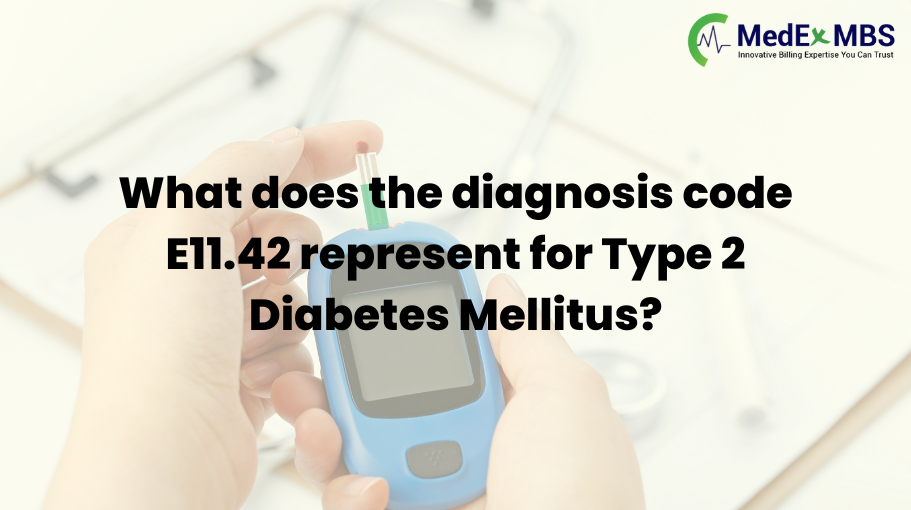What does the diagnosis code E11.42 represent for Type 2 Diabetes Mellitus?

The E11.42 code relates to type 2 diabetes mellitus that is associated with diabetic polyneuropathy as defined in the ICD-10 classification. What you will learn here: The E11.42 code specifically designates type 2 diabetes mellitus accompanied by diabetic polyneuropathy, thereby guaranteeing accuracy in both treatment and documentation. Symptoms associated with diabetic polyneuropathy encompass numbness and pain in the extremities, necessitating diagnostic procedures such as nerve conduction velocity tests. Managing the E11.42 code requires a comprehensive approach that includes medication, lifestyle modifications, and possibly insulin to achieve optimal patient outcomes. What is the E11.42 Code? The E11.42 code is a component of the ICD-10 classification system, utilized to identify type 2 diabetes mellitus with diabetic polyneuropathy. This condition signifies nerve damage resulting from diabetes, which can manifest in various symptoms. The E11.42 code serves not merely as an identifier but as a designation for a specific condition that demands targeted treatment and management. By accurately identifying this complication within the broader context of diabetes-related issues, the E11.42 code guarantees that patients receive appropriate care. It also facilitates precise documentation, which is vital for treatment planning and insurance reimbursement. Definition and Classification The E11.42 code is categorized within the ICD-10-CM classification system, a global standard for diagnosing and coding diseases and conditions. More specifically, it falls under the E08-E13 category, which encompasses various forms of diabetes mellitus. Understanding this classification system is essential for recognizing the type of diabetes mellitus and its associated complications, particularly diabetic polyneuropathy. In the ICD-10-CM, the E11.42 code is classified under endocrine, nutritional, and metabolic diseases, making it pertinent to metabolic disorders. This specific classification of diseases ensures that healthcare providers can accurately diagnose and treat patients, highlighting the importance of maintaining clear and detailed medical records. The Significance of Documentation Accurate documentation is essential for effective healthcare. The identification of type 2 diabetes mellitus accompanied by diabetic polyneuropathy requires a blend of physical assessments and specific diagnostic tests. Inadequate or erroneous documentation may result in improper billing, mismanagement of treatment strategies, and denial of claims. The E11.42 code must be applied with a high degree of specificity to the patient’s condition. This entails a clear definition of terms such as ‘uncontrolled’ diabetes and the establishment of the connection between diabetes and its complications. Such meticulous documentation guarantees that patients receive appropriate care and that providers can substantiate the medical necessity of treatments for insurance purposes. Symptoms and Diagnosis of Type 2 Diabetes Mellitus with Diabetic Polyneuropathy Type 2 diabetes mellitus with diabetic polyneuropathy is a condition characterized by various symptoms that significantly impact patients’ daily lives. Understanding these symptoms and the diagnostic processes is vital for effective management. Common Symptoms The prevalent symptoms of type 2 diabetes mellitus with diabetic polyneuropathy include numbness, tingling, and pain in the extremities. These symptoms arise from nerve damage and can greatly hinder a patient’s capacity to perform daily activities. Diabetic autonomic neuropathy may lead to gastrointestinal issues, bladder dysfunction, and cardiovascular irregularities. In severe instances, these symptoms can escalate to exercise intolerance, resting tachycardia, and other complications affecting multiple organ systems. Early recognition of these symptoms can facilitate timely intervention and management, thereby enhancing patients’ quality of life. Diagnostic Procedures The identification of type 2 diabetes mellitus accompanied by diabetic polyneuropathy requires a blend of physical assessments and specific diagnostic tests. Physical examinations include reflex tests aimed at assessing neurological function and identifying any abnormalities. One of the primary diagnostic tools is the assessment of nerve conduction velocity, which evaluates the speed and strength of signals transmitted through the nerves. These assessments are crucial for determining the degree of nerve damage and for accurately confirming the presence of diabetic polyneuropathy, thereby facilitating precise coding with E11.42. Treatment Options for Patients with E11.42 Code Managing type 2 diabetes mellitus accompanied by diabetic polyneuropathy necessitates a comprehensive approach. Treatment alternatives encompass medications, lifestyle modifications, and advanced therapies, all of which play a significant role in alleviating symptoms and enhancing patient outcomes. Medications typically serve as the initial line of defense against the pain and discomfort associated with diabetic polyneuropathy. Pregabalin and duloxetine are the only FDA-approved medications specifically for painful diabetic polyneuropathy. These drugs, along with alternatives such as gabapentin and amitriptyline, are effective in managing neuropathic pain. Antidepressants like duloxetine can also be beneficial for patients without depression, underscoring the versatility of these medications. They are essential for enhancing the quality of life for individuals suffering from chronic pain and discomfort. Lifestyle Changes Lifestyle modifications are crucial in managing type 2 diabetes and its associated complications. A well-balanced diet that includes vegetables, fruits, and whole grains can assist in maintaining stable blood sugar levels and minimizing the risk of additional complications. Engaging in regular physical activity is equally important. A minimum of 150 minutes of moderate exercise each week can enhance overall health, improve insulin sensitivity, and facilitate better management of diabetic polyneuropathy symptoms. Implementing these lifestyle changes can significantly impact a patient’s well-being and their ability to control diabetes. Advanced Therapies For certain patients, advanced therapies such as insulin therapy may be essential, particularly when oral medications alone fail to control blood sugar levels. Insulin therapy is instrumental in achieving optimal blood glucose regulation, which is vital for preventing additional complications and managing diabetic polyneuropathy. Tailored treatment plans incorporating insulin therapy can significantly enhance patient outcomes and offer a more holistic approach to managing type 2 diabetes alongside diabetic polyneuropathy. Complications of Type 2 Diabetes and Diabetic Polyneuropathy Type 2 diabetes accompanied by diabetic polyneuropathy can result in numerous complications, each of which must be addressed to ensure the best possible outcomes for patients. These complications can generally be classified into neurological, vascular, and other specified categories. Diabetic Neurological Complications Diabetic neuropathy, a prevalent complication linked to diabetes, entails considerable nerve damage that may present as pain, tingling sensations, and
